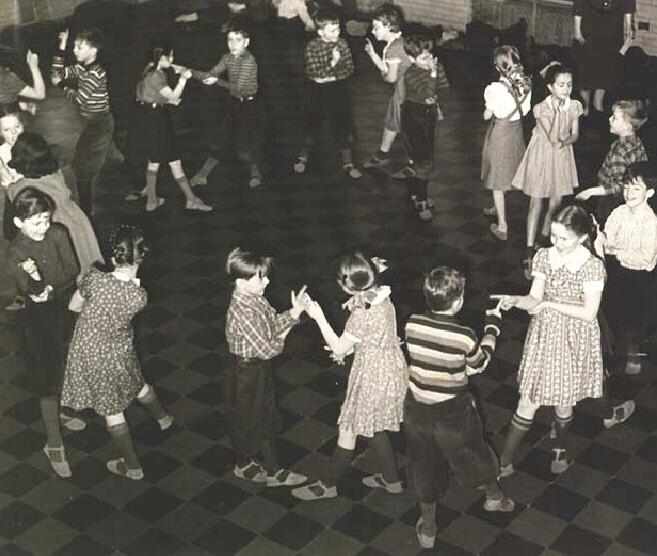
Clothing for Dancing Lessons: Chicago Public School (1935)

Figure 1.--We have only basic information about this school dance class. It is obviously an American school, in this case a 5th grade a public primary school neear Chicago in 1935. The knickers the boys are wearing suggest that the photograph are tupical for the 1930s. Apparently the school required the children to wear special sandals for the dance class. This was not common footwear for boys in an American school. It is very unusual to see American boys wearing sandals with knickers.
|
|
We have only basic information about this school dance class. It is obviously an American school, in this case a 5th grade a public primary school neear Chicago in 1935. The knickers the boys are wearing suggest that the photograph are tupical for the 1930s. Apparently the school required the children to wear special sandals for the dance class. This was not common footwear for boys in an American school. It is very unusual to see American boys wearing sandals with knickers. Click on the image for a fuller discussion.
The School
We have only basic information about this school dance class. It is obviously an American primaty (Elementary) school, almost certainly a public school. The children's clothes iare obvioysly American. The stripped long-sleave T-shirts and knickers are clearly American.
Location
The school was located near Chicago. It can get quite cold in Chicago during the winter. Thus corduroy knickers and long stockings or kneesocks would be suitable schoolwear during cold weather.
The Children
The children are in a 5th grade class which means that they are about 11-years old.
Dance Activity
The children are paired off to practice fancing. I assume thsat is being done in some sort of multi=purpose hall. Primary schools often did not have formal gymnasiums. They look to be practicing ball room dancing. I'm not sure what the ring arrangement is all about.
Chronology
The photograph of the class was taken in 1935. The knickers the boys are wearing suggest that the photograph are tupical for the 1930s.
Clothing
There are several interesting clothing aspects to this dance photograph.
Dresses
Notice virtusally all the grls wear dresses. One girl wears suspender skirts. Girls in the 1930s did not wear pants or shorts to school. Even in the 1950s grls still wore dresses to school.
Knickers
Almost all of the boys are wearing knickes. Corduroy knickers were especially common in the 1930s.
Kneesocks
Many of the girls are wearing kneesocks. It is not clear if the boys are wearing kneesocks or long stockings. As the girls do not appear to be wearing long stockings, we doubt if the boys are. Strangy the boys are wearing slid colored socks. We had thought tht in the 1930s that patterened kneesocks were commonly worn with knickers.
Sandals
Apparently the school required the children to wear special sandals for the dance class. I'm not sure what color they may have been, perhaps red. This was not common footwear for boys in an American school. It is very unusual to see American boys wearing sandals with knickers. This is a shoe style that girls might have to school, but it is not a stule Ameruican boys this age would have worn. These sandals would not have been worn to school. The uniformity could have been achieved only if the school provided them. (A required parental purchase is also popular, but school providing them seems more likely.) They must have been kept at school for use in the dance class, or perhaps gymnastics. We have never heard of schools providing sandals to children for school wear. A HBC reader provides us some details on the sandals, "The "sandals" both boys and girls are wearing in the picture are called "rhythm sandals" or "acrobatic sandals". They had a very soft sole, no heel, and no padding inside, and were intended originally (as their name suggests) for acrobatics and gymnastics. The style was "adopted" by some modern dancers for floors that were too dirty or splintery for bare feet. Unfortunately, these shoes had a tendency to come apart at the seams--they were stitched with very light thread--after a few wearings, and the original style was
discontinued about 15 years ago. A modified form of this shoe--better constructed and with no exposed seams, and with a small heel like a jazz oxford, is still being made. Capezio calls their version the Pedini; Bloch calls theirs a "Grecian Sandal". They are popular with ballet teachers."
HBC

Navigate the Historic Boys' Clothing Web Site:
[Return to the Main country dance lesson page]
[Introduction]
[Activities]
[Biographies]
[Chronology]
[Clothing styles]
[Countries]
[Girls]
[Topics]
[Bibliographies]
[Contributions]
[FAQs]
[Glossaries]
[Satellite sites]
[Tools]
[Boys' Clothing Home]
Navigate the Historic Boys' Clothing Web chronological pages:
[The 1900s]
[The 1910s]
[The 1920s]
[The 1930s]
[Thw 1940s]
[The 1950s]
[The 1960s]
[The 1970s]
[The 1980s]
[The 1990s]
[The 2000s]
Navigate the Historic Boys' Clothing Web style pages:
[Kilts]
[Caps]
[Sailor hats]
[Lederhosen]
[Sailor hats]
Created: February 2, 2004
Last updated: June 9, 2004



